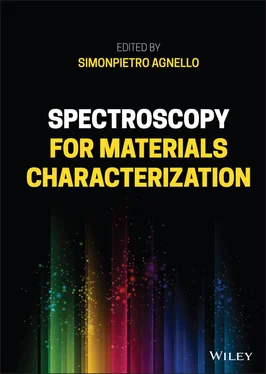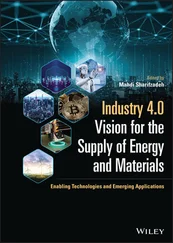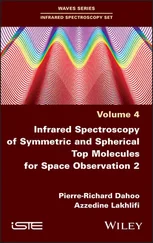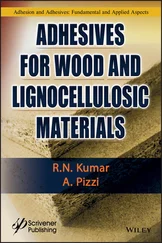1 ...8 9 10 12 13 14 ...46 (1.65) 
It is reasonable to assume that the number of absorbed photons is proportional to the number of atoms being excited by the radiation, so it can be written
(1.66) 
On the other hand, the number of emitted photons is proportional to the number of atoms relaxing radiatively from the E 2state, and it is possible to assume
(1.67) 
From the above considerations, it is found that the quantum efficiency is given by
(1.68) 
Introducing now the rate equation for the excited state
(1.69) 
it is found that after the stationary regime is attained, when the population N 2has stabilized, if the radiation field is suddenly removed at the time t 0and, as a consequence, R absis suddenly put to zero, the rate equation of the excited state becomes
(1.70) 
whose solution for t ≥ t 0is
(1.71) 
N 2( t 0) being the stationary population of the excited state. Comparing Eq. (1.71)with (1.23), it is found that
(1.72) 
and finally, it is found that
(1.73) 
It is worth considering that, typically, the non‐radiative processes are active at high temperature when the two‐level system is coupled to other degrees of freedom of the atomic system. At variance, at very low temperature, k nr= 0. On this basis, it is found that at T = 0 K (or at low enough temperature)
(1.74) 
(1.75) 
and a measure of the emission lifetime at low temperature, τ 0, is a direct estimate of k r. It is expected that the quantum efficiency decreases on increasing the temperature due to the activation of the non‐radiative relaxation processes [2, 5, 10]. In addition, the intrinsic or natural lifetime, τ 0= 1/ k r, can in general be determined at any temperature by the measure of the quantum efficiency and of the emission lifetime using (1.73)
(1.76) 
this shows that typically the lifetime decreases on increasing the temperature. In general, the lifetime concept and the quantum efficiency are relevant aspects in the dynamic study of emitting centers and in the characterization of optoelectronic devices. They give useful information on the coupling of the system to its neighborhood.
1.2.3 Vibronic States: Homogeneous and Inhomogeneous Lineshape
The absorption and emission processes have usually a dependence on the frequency ν of the exciting electromagnetic field. In particular, the amplitude of the absorption coefficient or the intensity of the emitted radiation changes by changing ν . This effect is related to the specific features of the centers interacting with the electromagnetic field through the distribution of the density of their electronic states as a function of ν or of the electron’s energy [8, 9]. In a given experiment, where the intensity of transmitted or emitted light is measured as a function of the frequency, a profile of I ( ν ) is recorded. This profile is usually called lineshape of the spectrum. In this context, it is possible to distinguish two contributions to the lineshape: homogeneous and inhomogeneous. This classification is related to the origin of the physical process contributing to the spectral width of the lineshape [2, 6, 11, 13]. It is now useful to consider a wider class of systems interacting with the radiation: the molecules. In this case, in addition to the degrees of freedom of the electrons, the degrees of freedom of the nuclei are present. In particular, not only the electrons can move and change their energy, but also the nuclei can move relative to each other, adding a contribution to the total energy of the system. The features affecting the lineshape can now be listed, collecting them in the above‐cited two classes [8, 13].
Homogeneous contributions
1 Once in the excited state, the electron should return to the starting state in a time that corresponds to the emission lifetime. This time, based on the Heisenberg uncertainty principle, is linked to an indetermination in the energy value of the excited state. Such effect gives rise to a spread in the energy of the transition and, as a consequence, a width of the lineshape. In addition, in the case of a gas of atoms or molecules, the collisions between the particles give rise to changes in the permanence time in the excited state and, therefore, impose changes to the lifetime and width of the lineshape.
2 When the system is a molecule, the vibrational degrees of freedom affect the distribution of energy levels and give rise to specific lineshapes (see Eq. 1.92).
Inhomogeneous contributions
1 When the atoms or molecules of a given species are embedded in an environment, the different spatial distributions of the other atoms and molecules originate local electric fields that cause a different energy levels’ separation and distribution among the centers under investigation.
2 When atoms or molecules move in space, their thermal velocity with respect to an observer fixed in space is randomly spread according to the Maxwell–Boltzmann distribution, giving rise to frequency variation of the absorbed or emitted light due to the Doppler effect.
Typically, the homogeneous effect is “intrinsic” to a given lineshape and the inhomogeneous effect induces a replica of the intrinsic lineshape, overall giving a broader lineshape that is the envelope of the many replicas. Neglecting the vibrations, the more common homogeneous lineshape is the Lorentzian, whereas the inhomogeneous lineshape is the Gaussian. The intermediate lineshape that is a Gaussian convolution of Lorentzian lineshapes is known as Voigt lineshape. The analytic forms of these functions are:
Читать дальше
























